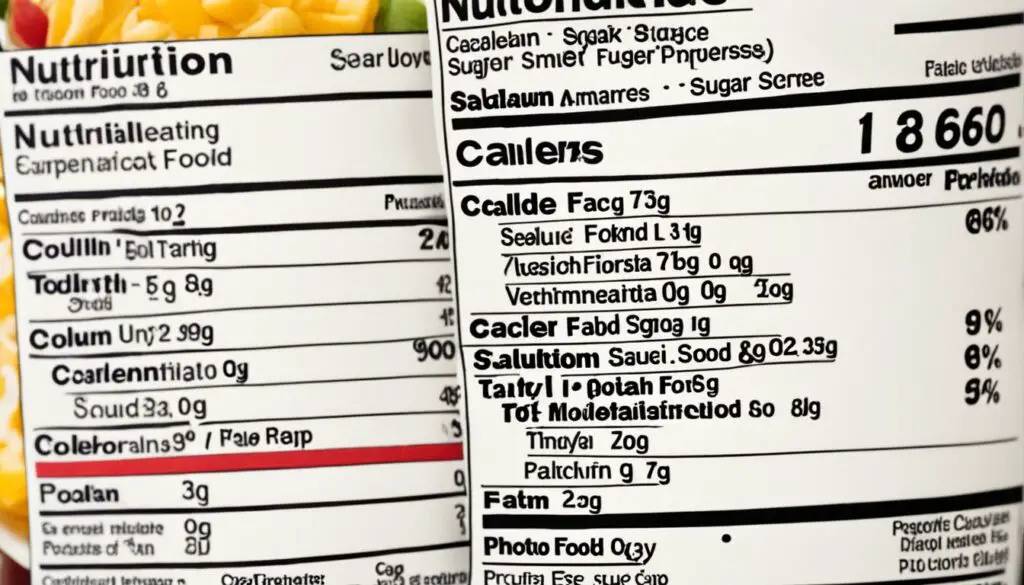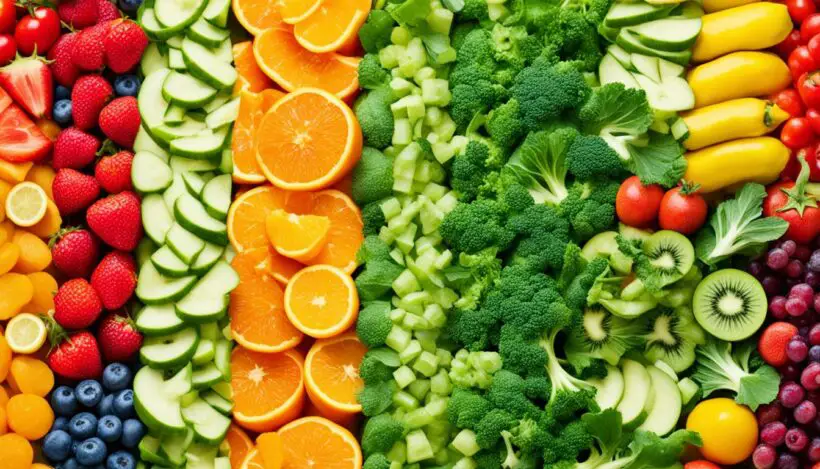Welcome to our article series on healthy eating and the impact of processed foods on nutrition. In today’s fast-paced world, convenience foods have become a staple in many people’s diets. However, it is important to understand the difference between healthy foods and highly processed foods and how they can affect our overall health and well-being.
Processed foods have become increasingly prevalent in our society due to their convenience and longer shelf life. These foods often undergo various processing methods and contain added ingredients that can have negative effects on our nutrition. It is crucial to make informed choices and prioritize whole, nutrient-dense options for a balanced diet.
In this article series, we will delve into the world of processed foods, exploring what makes them highly processed, understanding their impact on our health, and learning how to make healthier choices. Whether you’re a busy professional or a health-conscious individual, this series will provide you with valuable insights to help you navigate the aisles of the grocery store and make informed decisions about the foods you consume.
What are Highly Processed Foods?
Highly processed foods, also known as ultra-processed foods, undergo extensive food processing and contain a range of additives and preservatives to enhance their taste, texture, and shelf life. These foods are typically low in healthy ingredients and high in sugars, refined grains, and unhealthy fats.
When it comes to food processing, highly processed foods are at the top of the processing hierarchy. They are made from inexpensive ingredients and often undergo multiple processing steps, including refining, extracting, and chemically modifying the raw ingredients.
Some common ingredients found in highly processed foods include hydrolyzed proteins, modified starches, artificial sweeteners, and preservatives. These additives are used to enhance flavor, texture, and appearance while extending the product’s shelf life.
Unfortunately, highly processed foods are often lacking in essential nutrients. They are typically stripped of their natural fiber, vitamins, minerals, and antioxidants during the refining and processing stages. This is why it’s important to prioritize whole, minimally processed foods in your diet to ensure you’re getting the nutrients your body needs.
Examples of Highly Processed Foods
When it comes to highly processed foods, there are some common examples that you may come across in your everyday life. These foods often fall into the categories of packaged foods, food additives, and processed beverages.
One example of a highly processed food is sugary beverages. These include sodas, fruit juices, energy drinks, and flavored waters. They often contain high amounts of added sugars, artificial colorings, and flavorings. Consuming these beverages regularly can contribute to weight gain and increase the risk of developing chronic conditions like obesity and type 2 diabetes.
Another common example is packaged snacks. These can include items like chips, cookies, crackers, and snack bars. Packaged snacks are typically high in unhealthy fats, refined grains, and added sugars. They are often made with artificial ingredients and preservatives to enhance flavor and prolong shelf life.
Breakfast cereals are also a popular example of highly processed foods. Many cereals marketed towards children, in particular, are loaded with sugar and artificial additives. Opting for whole grain cereals with minimal added sugars and artificial ingredients is a healthier choice.
Frozen meals are convenient options for those with busy lifestyles, but they can be highly processed. These meals are often high in sodium, unhealthy fats, and artificial additives. Preparing homemade meals from scratch or choosing frozen options with minimal processing and healthier ingredients can be a better alternative.
Lastly, energy bars are another example of highly processed foods. While marketed as a quick and healthy snack option, many energy bars are packed with added sugars, artificial sweeteners, and preservatives. It’s important to read the ingredient list and choose energy bars that are made with whole, natural ingredients.
Overall, highly processed foods can be found in various forms, including sugary beverages, packaged snacks, breakfast cereals, frozen meals, and energy bars. Be aware of the artificial colorings, flavorings, sweeteners, and preservatives often found in these foods, and strive to make healthier choices by opting for minimally processed alternatives.
What are Considered Healthy Foods?
When it comes to making nutritious choices for your diet, whole foods and nutrient-dense foods should be at the top of your list. These types of foods are typically unprocessed or minimally processed, meaning they retain their natural goodness and are packed with essential nutrients. Incorporating more whole foods into your meals can have a positive impact on your overall health and well-being.
Whole foods encompass a wide range of options, including fresh fruits and vegetables, whole grains, lean meats, and dairy products. These foods are rich in vitamins, minerals, fiber, and antioxidants, providing your body with the essential building blocks for optimal function. By consuming whole foods, you not only get the nutrients your body needs but also enjoy the natural flavors and textures that these foods offer.
In contrast, highly processed foods undergo extensive refining and often have added sugars, unhealthy fats, and artificial ingredients. These highly processed options tend to be lower in nutritional value and can contribute to health issues when consumed in excess. By opting for whole foods, you can avoid many of the pitfalls associated with highly processed alternatives, such as excessive calorie intake and nutrient deficiencies.
When planning your meals, consider incorporating a variety of whole foods from different food groups. This ensures a well-rounded and balanced approach to eating. Fresh fruits and vegetables offer a rainbow of vitamins and minerals, while lean meats provide essential proteins for tissue repair and growth. Whole grains and dairy products are excellent sources of fiber, calcium, and other vital nutrients.
By making whole foods the foundation of your diet, you prioritize your health and provide your body with the necessary nutrients to thrive. These nutrient-dense options not only nourish your body but also support overall well-being.
Main Differences Between Minimally Processed and Highly Processed Foods
When it comes to the nutritional value of foods, the way they are processed can make a significant difference. Highly processed foods tend to have higher calorie content, sugar content, and unhealthy fats compared to minimally processed foods. On the other hand, minimally processed foods are typically lower in calories and sugars and are higher in beneficial nutrients.
Highly processed foods often undergo extensive refining, which can strip them of essential nutrients while increasing their calorie and sugar content. These foods are often loaded with added sugars, unhealthy fats, and artificial additives to enhance flavor and prolong shelf life. As a result, they tend to be less nutritious compared to their minimally processed counterparts.
Minimally processed foods, on the other hand, are closer to their natural state and retain more of their original nutrient content. They are typically higher in fiber, protein, vitamins, and minerals, making them a healthier choice for overall nutrition.
It’s important to note that not all processed foods are unhealthy. Some minimally processed foods, such as cut vegetables or roasted nuts, can still be part of a nutritious diet. The key lies in choosing foods that are minimally processed and rich in essential nutrients.
By opting for minimally processed foods and reducing our intake of highly processed foods, we can make significant improvements to our overall health and well-being. So, the next time you’re at the grocery store, try to fill your cart with fresh fruits and vegetables, whole grains, lean proteins, and other nutrient-dense choices.
Why Some Processed Foods Are Less Healthy
Certain processed foods contain high levels of salt, sugar, and fat to enhance flavor, extend shelf life, or improve the texture of the product. While these additives may make the food more palatable, they can also lead to excessive consumption of unhealthy substances.
High amounts of salt, sugar, and fat in processed foods can have detrimental effects on our health. Excessive salt intake is linked to high blood pressure and an increased risk of cardiovascular diseases. Similarly, consuming too much sugar can contribute to weight gain, obesity, and the development of chronic conditions like type 2 diabetes. Additionally, a diet high in unhealthy fats can raise cholesterol levels and increase the risk of heart disease.
It’s important to pay attention to the salt, sugar, and fat content when choosing processed foods. Reading nutrition labels and ingredient lists can help you make more informed decisions about the foods you consume. Opting for products with lower amounts of these unhealthy ingredients and choosing whole, nutrient-dense options whenever possible can lead to a healthier and more balanced diet.
To illustrate, let’s take a look at the infographic below:
Eating Processed Foods as Part of a Healthy Diet
While nutrition labels may seem overwhelming, they can actually be a useful tool in making healthier choices when it comes to processed foods. By reading and understanding these labels, you can gain valuable information about the amount of salt, sugar, and fat in the products you consume. This knowledge can help you make informed decisions and opt for options that align with your health goals.
When examining nutrition labels, pay attention to the serving size and the total calories per serving. Keep in mind that the serving size may not always align with what you typically consume, so be cautious when comparing different products.
In addition to calories, it is important to evaluate the amounts of salt, sugar, and fat. Aim for products that have lower quantities of these ingredients, as excessive consumption can contribute to various health concerns in the long run.
- Look for processed foods with lower sodium content. Opting for lower-sodium options can help control your daily salt intake and reduce the risk of high blood pressure.
- Choose products with lower sugar content. Highly processed foods tend to be high in added sugars, which can contribute to weight gain and increase the risk of chronic conditions like diabetes and heart disease.
- Make sure to select items with less saturated and trans fats. These types of fats can raise cholesterol levels and lead to heart problems over time.
By carefully examining nutrition labels, you can make healthier choices when it comes to processed foods. Remember to focus on lower amounts of salt, sugar, and fat, and opt for products that align with your dietary needs and preferences. Eating processed foods in moderation, while prioritizing whole foods, can contribute to a balanced and nutritious diet.

Food Processing and Safety
Not all food processing is unhealthy. In fact, certain food processing methods are necessary for food safety and preservation. Processes like pasteurization, freezing, canning, and cooking help to minimize the risk of foodborne illnesses and extend the shelf life of perishable foods.
Pasteurization, for example, involves heating liquid foods to kill or deactivate harmful bacteria, viruses, and parasites. This process is commonly used for milk, fruit juices, and other beverages. Freezing is another common food processing method that helps to preserve the nutritional content of foods while extending their shelf life. Canning involves sealing food in airtight containers to prevent spoilage and contamination.
Additionally, cooking is a vital food processing method that not only enhances the flavor and texture of foods but also helps to eliminate harmful pathogens. Through cooking, the heat kills bacteria and other microorganisms, making the food safe to consume.
When it comes to food processing, it is important to understand the purpose behind these methods. They are designed to ensure food safety and reduce the risk of foodborne illnesses. However, it is equally important to make informed choices about the types of processed foods we consume.
Balancing Processed and Whole Foods
When it comes to maintaining a healthy diet, it’s important to strike a balance between processed foods and whole, nutrient-dense foods. While processed foods can be convenient and enjoyable, they should not make up the majority of your diet.
Whole, unprocessed or minimally processed foods provide essential nutrients and are generally healthier options. Fruits, vegetables, whole grains, lean proteins, and dairy products should form the foundation of your meals.
However, that doesn’t mean you can’t enjoy processed foods in moderation. Here are some tips for incorporating processed foods into a balanced diet:
- Choose processed foods that are lower in added sugars, unhealthy fats, and sodium.
- Read food labels to make informed choices about the nutritional content of packaged foods.
- Opt for whole-grain versions of processed foods like bread, pasta, and cereals.
- Limit your consumption of processed snacks and opt for healthier alternatives like nuts, seeds, or homemade treats.
- Focus on portion control when consuming processed foods to avoid excessive calorie intake.
By balancing processed foods with whole, nutrient-dense options, you can enjoy a varied and satisfying diet while still prioritizing your health and well-being.
Tips for Making Healthier Choices
When it comes to making healthier food choices, one of the most important steps is to read the ingredient lists on food labels. This can provide valuable information about the nutritional content of the product and help you make more informed decisions.
Here are some tips to keep in mind:
- Avoid products with artificial additives: Look for products that have minimal amounts of artificial flavors, colors, and preservatives. These additives can negatively impact your health and may contribute to various health issues in the long run.
- Watch out for high levels of added sugars: Added sugars can be found in many processed foods, even those that do not taste particularly sweet. Be mindful of hidden sugars, such as corn syrup, fructose, and sucrose, as they can add up quickly and increase your calorie intake.
- Avoid unhealthy fats: Some processed foods contain unhealthy fats, such as trans fats and saturated fats. These fats can increase your risk of heart disease and other health problems. Opt for products that are labeled as low in saturated and trans fats.
- Choose whole, natural ingredients when possible: Whenever you have the option, choose products that contain whole, natural ingredients. Whole foods are generally less processed and contain more nutrients, fiber, and vitamins.
By following these tips and being mindful of the ingredients in the foods you consume, you can make healthier choices for yourself and your family.
Impact of Highly Processed Foods
Consuming a diet high in highly processed foods can have detrimental effects on your health, increasing the risk of obesity, heart disease, type 2 diabetes, and other chronic diseases. These health conditions can significantly impact your quality of life and lead to long-term health complications.
Highly processed foods contain high levels of unhealthy fats, refined sugars, and artificial additives, while being low in essential nutrients. This combination can contribute to weight gain, elevated cholesterol levels, and insulin resistance, leading to an increased risk of chronic diseases.
Obesity, a common consequence of consuming a diet high in highly processed foods, increases the likelihood of developing conditions such as high blood pressure, heart disease, and stroke. These conditions can be life-threatening and require long-term management.
Type 2 diabetes, another disease linked to highly processed food consumption, can have serious health effects, including nerve damage, kidney disease, and vision problems. Managing blood sugar levels becomes crucial in order to prevent these complications.
By prioritizing whole, nutrient-dense foods in your diet, you can help mitigate the negative health effects associated with highly processed foods. Opt for fresh fruits and vegetables, whole grains, lean proteins, and healthy fats. These foods provide essential nutrients and promote overall well-being.
It is important to be mindful of your food choices and strive for a balanced diet that includes a variety of minimally processed and whole foods. Making healthier choices can significantly improve your health and reduce the risk of chronic diseases.
Next, we will explore the importance of understanding food processing methods and making informed decisions.
Conclusion
In conclusion, understanding the difference between processed and highly processed foods is essential for making healthier choices and improving overall well-being. While it’s not necessary to completely eliminate processed foods from your diet, it is crucial to prioritize whole, nutrient-dense options for a balanced and nutritious eating plan.
Processed foods can be a convenient part of a busy lifestyle, but it’s important to be mindful of their impact on health. Opting for minimally processed foods like fresh fruits, vegetables, whole grains, lean meats, and dairy products can provide essential nutrients while reducing the intake of added sugars, unhealthy fats, and artificial additives often found in highly processed foods.
By reading nutrition labels and ingredient lists, you can make more informed choices and be aware of the salt, sugar, and fat content in processed foods. Aim for products with lower amounts of these substances to prioritize your health. Incorporating a balance of processed and whole foods into your diet can help you achieve optimal health and reduce the risk of chronic diseases associated with a high intake of highly processed foods.






